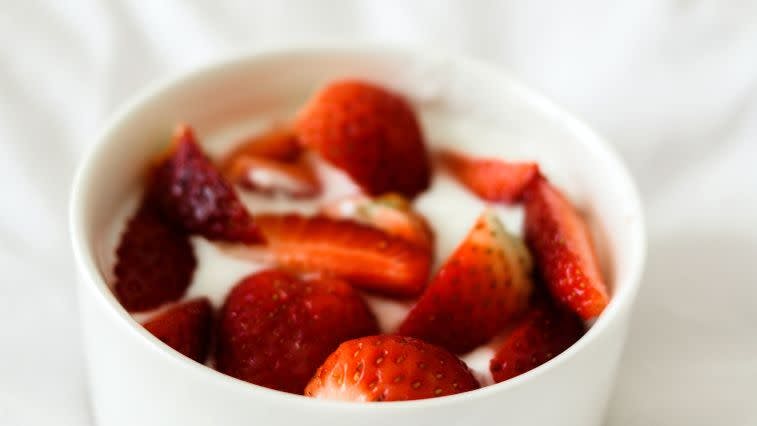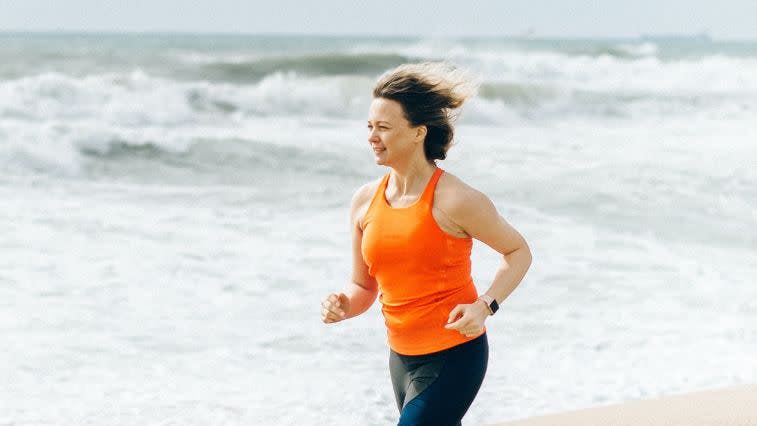An RD’s Advice on How Much Protein You Need to Build Muscle
No, it’s not the same for everyone and may be less than you think
Our content strives to support, inform, and motivate you to meet your health goals. We want to be your trusted source of expert- and science-backed info dispensed in simple, actionable ways. Read our Editorial Guidelines.
How much protein should you be eating? There’s no hard and fast answer.
Multiple factors impact protein requirements including activity level, age, sex, and stage of life. Infants have fairly high protein needs per kilogram of body weight, given their state of growth, yet low overall protein needs since their bodies are so small.
The Nutrition Facts panel on a food label gives specific percentages of daily value recommendations for carbohydrates, fats, fiber, some vitamins and minerals. Protein is a bit of an anomaly.
The percent daily value for protein isn’t listed for a product since everyone could have different protein requirements. As a general rule of thumb, if a food contains 6 grams of protein per serving, it’s considered a “good” source of protein.
But, how do you know how much protein you need to build muscle or meet other health goals? I’ll share what I tell my clients and walk you through the logic of how and why the protein requirements can differ based on individual needs.
Calculating Protein Needs
Protein requirements are based on several variables. An active young adult trying to build muscle may need more than her sedentary cousin. As a registered dietitian, I’ve counseled countless men and women on their individual protein requirements — and their use of protein shakes or smoothies to build muscle.
The baseline protein needs for most adults is 0.8 to 1.0 grams of protein per kilogram of ideal body weight, according to the National Academy of Medicine. For building muscle and losing body fat, more protein may be necessary. Including 20 grams of protein per meal may prevent muscle loss when you want to lose weight.
For most people, 100 grams of protein a day is enough and I would advise against eating 200 grams of protein per day.
Consider that one gram of protein has 4 calories. With 200 grams of protein, a person could be eating up to 50% of their calories (800 per day) from protein. This would crowd out other food and nutrients your body needs. Studies show that chronic consumption of more than 2 grams of protein per kilogram of body weight does not result in improved muscle mass and could cause digestive, kidney, or vascular problems.
How Much Protein Is Needed to Support Exercise While Nursing?

Rachel is a 32-year-old new mom who wants to get back in shape post-pregnancy. She's been breastfeeding for five months and trying to work out three to four days per week with circuit training (combined cardio + strength training). She is 5’7" and weighs 175 pounds. What are her calorie and protein requirements?
For starters, I want to make sure that Rachel isn’t starving herself to lose body fat. Women that are nursing have higher energy (calorie) and protein requirements to support lactation.
No one should ever drop below 1,200 calories per day, as it’s not enough to support normal physiologic functions (metabolism, digestion, respiration, etc.) and it’s difficult to get adequate nutrition in 1,200 calories. Eating enough calories spares protein from being used for calories, so muscle mass is maintained.
Based on Rachel’s height, weight, activity level, and breastfeeding requirements, I calculated her calorie and protein needs using this great USDA tool. Rachel’s nutrient needs are 3,000 calories and 103 grams of protein per day. To lose weight, I’d reduce her calories to 2,500 per day so she can drop roughly one pound per week.
Rachel’s Sample Daily Meal Plan
Breakfast:
2 scrambled eggs (14 grams of protein)
2 slices whole wheat toast (10 grams of protein)
1 Tbsp. whipped butter
1 (8 oz) glass 1% milk or soy milk (8 grams of protein)
1 orange
Lunch:
4 oz. tuna salad (16 grams of protein)
2 cups romaine lettuce (1 gram of protein)
1/4 cup garbanzo beans (2 grams of protein)
1 Tbsp. sunflower seeds (2 grams of protein)
6 Triscuit crackers (2 grams of protein)
2 Tbsp. Italian dressing
1 cup blueberries
Afternoon Snack:
5 oz. plain Greek yogurt (10 grams of protein)
½ cup grapes
¼ cup almonds (6 grams of protein)
Dinner:
4 oz. grilled chicken (25 grams of protein)
1 cup steamed broccoli (1 gram of protein)
1 cup mashed sweet potato (4.5 grams of protein)
2 tsp. whipped butter
1 cup (8 oz) 1% milk or soy milk (8 grams of protein)
Rachel’s daily protein total: 109.5 grams

Protein Needs for a Busy Male
My friend Tim is a 40-year-old sedentary male who wants to lose weight and build more muscle. He works until 6pm, doesn’t cook much, and gets to his gym three times a week. He is 5’11 and 225 pounds.
I calculated 2,700 calories and 82 grams of protein based on his goal to lose weight and build muscle. While this protein requirement may seem low, his needs are based on ideal body weight, not actual weight. At 5’11", Tim’s ideal weight is 172 pounds (78 kg).
Tim might benefit from a bit higher protein intake if he’s trying to lose weight. One study found that consuming 1.34 grams of protein per kilogram of body weight helped with weight loss. This would bump Tim’s needs up to 104 grams of protein per day.
Protein shakes might be a good option for Tim, given his busy lifestyle and limited interest in cooking. Most shakes have 15 to 20 grams of protein per serving. A recent 12-week study found that using a protein- and fiber-based drink before meals resulted in better weight loss than a shake with less protein and fiber. When it comes to muscle repair, having a shake after a workout appears to be better.
Below is what I suggested to Tim. While this is above 104 grams of protein, it’s not excessive (1.49 grams per kg), and may help him build more muscle.
Tim’s Sample Daily Meal Plan
Morning Snack:
Orgain protein shake (20 grams of protein)
Breakfast:
½ cup cottage cheese (13 grams of protein)
15 Wheat Thin crackers (2 grams of protein)
1 banana
Lunch:
3 oz. turkey breast (21 grams of protein)
2 slices rye bread (8 grams of protein)
1 slice Swiss cheese (5 grams of protein)
2 cups raw veggies (carrots, celery, bell pepper strips)
1 medium apple
Dinner:
3 oz. rotisserie chicken (20 grams of protein)
1 cup frozen green beans, microwaved (2 grams of protein)
1 tsp. whipped butter
1 cup brown rice (5 grams of protein)
1 cup cantaloupe
Evening Snack (post workout):
Orgain protein shake (20 grams of protein)
Tim’s Daily Protein Total: 116 grams
Protein Needs for a Post-Menopausal Runner

Menopause is a tricky time for women. While women may still be active, sleep disturbances, hormonal changes, and stress can impact their eating habits and weight. Working with a registered dietitian and exercise specialist (certified personal trainer or physical therapist) has been found to be better in preventing weight gain than self-directed efforts.
Megan is my neighbor and friend with one teenage son at home. She was an avid marathon and half-marathon runner but has given up competitive racing. She still likes to get out and run four times per week, and also does household chores and gardening. She’s complained of a “muffin top,” weight gain, and pre-menopausal symptoms including hot flashes. She is 52, 5’3”, and weighs 150 pounds.
I assessed Megan’s calorie and protein needs at 1,700 calories and 54 grams of protein per day, which provides roughly 1 gram of protein per kg (ideal weight). Since she wants to lose belly fat and reduce hot flashes, I recommended that she limit or avoid alcohol, as this may worsen both. Cutting added sugar from desserts, snacks, and sweetened drinks may also help her lose that muffin top. Below is her daily meal plan.
Megan’s Sample Daily Meal Plan
Breakfast:
5 oz. Greek yogurt (10 grams of protein)
1 Tbsp. sunflower seeds (1.6 grams of protein)
1 slice whole wheat toast (5 grams of protein)
1 tsp. whipped butter
¾ cup strawberries
Lunch:
½ cup black beans, seasoned (7 grams of protein)
½ cup cooked quinoa (11 grams of protein)
2 Tbsp. salsa
1 Tbsp. cheddar cheese, shredded (2 grams of protein)
2 cups raw spinach (1.6 grams of protein)
2 Tbsp. light dressing
1 cup (8 oz) 1% milk or soy milk (8 grams of protein)
1 pear
Dinner:
3 oz. baked fish (17 grams of protein)
½ cup whole wheat couscous (3 grams of protein)
1 cup stir-fried vegetables (carrots, broccoli, cauliflower)
1 Tbsp. canola oil
1 tsp. whipped butter
2 tangerines
Megan’s Daily Protein Total: 66.2 grams
How Can a Skinny Guy Gain Muscle?
We all have at least one friend who can eat anything and not gain weight. It’s not fair! Brayden is an “always-been-thin” 24-year-old with a fast metabolism. He’s been lifting weights regularly for about a year but isn't seeing the muscle definition or bulk that he wants. He sought me out to help him gain muscle. He is 6’2” and weighs 150 pounds.
The first thing we talked about was getting enough overall calories to prevent weight or muscle loss. Brayden doesn’t do much cardio because it makes him lose weight. He’s been using free weights three times each week to gain muscle.
Based on his age, height, weight, sex, and activity level, Brayden’s calorie and protein needs are 3,050 calories and between 68 to 82 grams of protein per day. Taller individuals use more body heat, which means they have a higher metabolism. In order to meet his high-calorie demand, Brayden would benefit from eating three meals and a few calorie-dense snacks per day. Protein shakes or smoothies would work well for him.
He could also benefit from adding more dairy in his diet. A recent study on men his age found that 30 grams of protein from either cheese or milk increased muscle-building rates at both rest and recovery from exercise. This means the timing of protein intake may not matter for muscle building.
Below is Brayden’s sample meal plan.
Brayden’s Sample Daily Meal Plan
Breakfast:
1 cup of rolled oats (10 grams of protein)
1 tsp. whipped butter
¼ cup almonds (6 grams of protein)
1 fruit smoothie with plain Greek yogurt (12 grams of protein)
Morning Snack:
1 string cheese (6 grams of protein)
1 apple
12 Triscuit crackers (4 grams of protein)
Lunch:
3 oz. roast beef (21 grams of protein)
1 slice cheddar cheese (6 grams of protein)
2 slices multigrain bread (4 grams of protein)
1 Tbsp. mayonnaise
2 cups spinach salad
2 Tbsp. ranch dressing
1 cup orange juice
1 cup cantaloupe
Dinner:
3 oz. grilled chicken strips (20 grams of protein)
1 large whole-wheat tortilla (3 grams of protein)
1 cup peppers and onions, sauteed
2 Tbsp. cheddar cheese, shredded (4 grams of protein)
1 cup 2% milk (8 grams of protein)
Evening Snack:
3 cups popcorn
Brayden’s Daily Protein Total: 104 grams While this meal plan provided more than Brayden’s calculated protein needs, it wouldn’t be harmful to him.
The Bottom Line
Popular diets push lots of protein, but keep in mind that your body needs other fuel (carbs and fats) to function. Protein shakes are a convenient way to get protein in your diet, but they aren’t needed by everyone and can be expensive. They also add calories to your diet, which need to be factored into your overall meal plan.
If you’d like help with your diet and meal planning, an expert can help! Reach out to a registered dietitian, or check out the Kickoff app’s nutrition features and learn how you can work with a certified expert to help you reach your body composition goals.